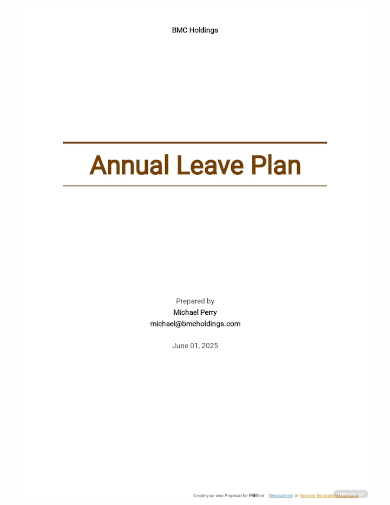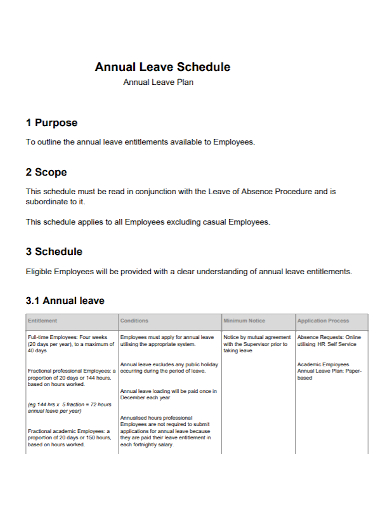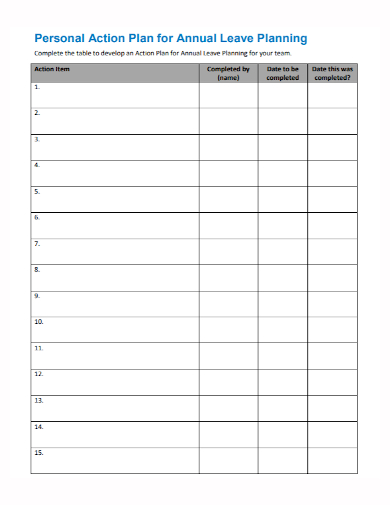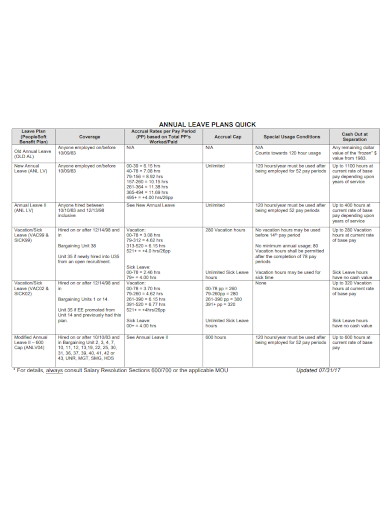Every employee deserves to get leave credits; after all, employees need to unwind and rest from the stress of their works for a while. And they also need those leave credits if unfortunate situations, such as getting sick or dealing with personal problems, happen and they will be unavailable to show for work. That’s why companies and organizations set an annual leave plan for their employees to use and enjoy. The annual leave plan consists of sick or vacation leave days that employees can use and it also includes a 12-month calendar where the employees can plot their leave in advance to let their employers know when they will be unavailable for work. Since leave credits are awesome perks that employees are entitled to use, make sure to use them efficiently. Read the article to know how to make use of your annual leave plan.
3+ Annual Leave Plan Samples
1. Annual Leave Plan Template

2. Annual Leave Schedule Plan
3. Annual Leave Action Plan
4. Annual Quick Leave Plan
What is an Annual Leave?
Annual leave is a paid time-off from work granted by employers to their employees to be used if they want to take a break from work or if they will fall ill or go through a personal conflict that they need to attend to urgently. Depending on the employer’s policies, they give a certain number of days to the employee for them to leave and some employers may require their employees to give a certain amount of notice in advance.
Tips on Planning For Your Leave
1. Manage Your Office Work and Your Schedule
If you’re planning to some time off from work, you need to plan on how to manage your tasks and your schedule leading up to your time-off. Take any important tasks days before your time off and let your co-workers and clients know that you will be away on annual leave soon. Give your clients the contact details of the co-worker who will substitute for you while you’re away in case they need something. Don’t forget to brief your substitute to orient him or her about your tasks.
2. Prioritize Your Major Workload
You might have some big tasks such as projects to work on after your time off. If you have multiple responsibilities and workloads, prioritize first the major workload you have to do after you’re back from your vacation so you will know the first thing that you will work on once you’ve returned. If that workload is too crucial to put off, ask your substitute, a co-worker who will vouch for your load, to work on it a bit after you’ve returned.
If you’re the type of person who doesn’t want to leave a half-finished project, take some time before your time-off to complete them to give you some peace of mind while you’re on vacation. This is also beneficial for your co-workers who don’t have to do too much workload for you. If you have small tasks you need to do, try to do them by yourself and finish them before you leave.
3. Plan Your Tasks By Using Your Schedule
To help you prioritize which tasks should be done before and after your time off, you need to check your schedule calendar to see which tasks must be done before your time off and which tasks will be worked on after your time off. This is useful to anticipate the needs or concerns of these tasks that may affect your co-workers and your clients and you already know what to do after you come back to the office.
4. Assign Some of Your Tasks to Your Co-Workers
Check with your co-workers who will be available to do your workload while you’re away. Once you’ve found someone who can do it, orient them well on each task or project that they can do and encourage them to ask any questions regarding the tasks you’ve assigned to them. Prepare all the resources they need to work on your project and make sure to give further instructions just in case if any concerns may come up while you’re away.
5. Inform Your Clients That You Will be on Leave
Don’t forget to inform your client, through an email or voicemail, that you will be out of the office explaining that you are on your annual leave. Include the date of when you will return and give them the contact details of your substitute in case of emergency.
FAQs
What are the different types of leave?
The different types of leaves are annual leaves, parental leave, personal leave, community service leave, and long service leave (observed by Australia and New Zealand).
How many days are there in an annual leave?
Annual leaves are made up of 21 consecutive days on full remuneration.
If you prepare well before you take your time off, you will have a stress-free break without worrying about leaving any work undone back at the office. Make sure to do the tips mentioned above whenever you take a long break. However, in cases like an unexpected situation where you need to take a leave, don’t forget to inform your employer and your colleagues regarding your situation right away, so they can vouch for your workload while you’re gone. To help you make your annual leave plan or make one for your office for the coming year, download our free sample templates above to use as your guide!
Related Posts
FREE 9+ 30-Day Marketing Plan Samples in PDF | MS Word | Apple Pages | Google Docs
FREE 3+ Sales Team Action Plan Samples in PDF | MS Word | Apple Pages | Google Docs
Marketing Plan For Small Business Samples
FREE 7+ Fashion Business Plan Samples in PDF
FREE 10+ Sprint Planning Samples In MS Word | Google Docs | PDF
FREE 10+ Wedding Planning Samples in MS Word | Apple Pages | Powerpoint | PDF
FREE 9+ Monthly Study Planner Samples in PSD | Illustrator | InDesign | PDF
FREE 9+ Sample Curriculum Planning Templates in PDF | MS Word
FREE 10+ Teacher Development Plan Samples in MS Word | Google Docs | Apple Pages | PDF
FREE 10+ Basketball Practice Plan Samples in PDF
FREE 12+ School Business Plan Samples in PDF | MS Word | Apple Pages | Google Docs
FREE 7+ Client Strategic Plan Samples in PDF | MS Word
FREE 11+ Trucking Business Plan Templates in PDF | MS Word | Google Docs | Pages
FREE 7+ Small Hotel Business Plan Samples PDF | MS Word | Apple Pages | Google Docs
FREE 14+ Bakery Business Plans in MS Word | PDF | Google Docs | Pages



